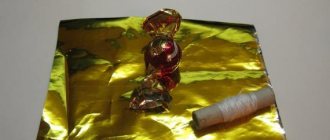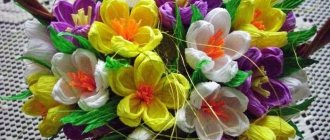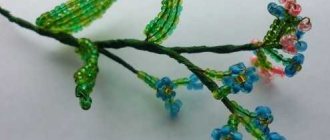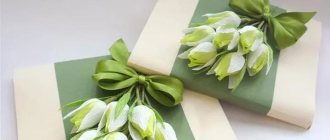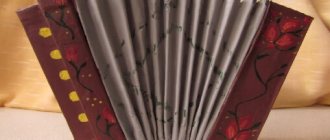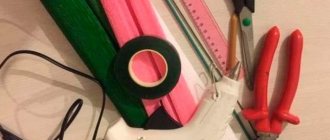General principles and rules
Despite the fact that flowers are made from corrugated paper differently, the principles of operation are the same. Here are some general rules that will help you make paper flowers with your own hands that are very similar to real ones.
- Cut out several petals of the same size at once. To do this, fold the paper in several layers.
- Petals are usually made in different sizes. Roses, for example, have at least four different ones, while daisies have 2-3. In general, you can follow the rule - the more petals a flower has, the more different sizes there are. Lovely flowers made of corrugated paper can decorate your interior or become a gift
- Don't try to make the petals and leaves perfectly even or exactly the same. In nature they are different and unique. The same should happen for you.
- When twisting the petals onto the stem, press the wrapped part well with your fingers, twisting the paper around the stem. The more tightly you press, the more tightly the petals will fit one to the other. By adjusting this force, flowers of different sizes and appearances can be obtained from absolutely identical petals.
- Coat each petal wound onto the stem with glue.
That, in fact, are all the rules. And one more thing: the stem is cooked first. It uses wire or sticks of different thicknesses, which are wrapped in a long thin strip of green corrugated paper. The tape can be coated with glue and then screwed onto the base. You can twist it dry and secure the edge with a drop of glue. One more point: if you are going to assemble a composition from flowers, leave the lower 1/3 of the stem without decoration - it will be easier to compose a bouquet.
Advantages of bead weaving
At all times of the existence of this type of needlework, products made from beads were considered noble and worthy of admiration, and embroidery and flower weaving were considered an elegant decoration for fashionistas. This activity also brings another kind of benefit: the positive effect of beadwork on the health of the needlewoman has long been known. Several hours devoted to creating knots and loops with beads strung on them help not only to end up with a nice little thing, but also:
- cope with insomnia;
- train attention;
- get rid of headaches and even toothaches;
- improve your emotional state.
What a reason to go to the store for beading supplies!
poppies
Poppies from corrugated paper are very easy to make. It is important to find the right shade of scarlet. You will also need a small piece of black for the core. But, if you don’t have it, you can use any dark one and then paint it black.
We make a poppy from corrugated paper like this:
- Fold a small square from paper napkins of any color. We wrap it in black corrugated paper. If you don’t have black, take any dark one, then we’ll paint it.
Making the core - We cut out two or three petals of different sizes from scarlet paper: small, medium and large.
- We collect the petals all together (do not put them in a neat pile) and crush them into a ball.
- We disassemble the ball into petals.
Preparatory work - We take the core and wrap the first small petal around it from left to right.
- The second small petal partially overlaps the first, followed by the middle one, also overlapping it. We collect flowers from corrugated paper with our own hands
- The second middle and two large petals form the second row. They are located so that their central part overlaps the junction of the previous row. We give shape and design the stem
- Having collected everything together, we insert the wire into the base, wrap the base with thread, and glue it. Wrap in green paper. Here's a flower made from corrugated paper
Poppy is one of the easiest flowers to make yourself from crepe paper. At the same time, he looks very good. You can use them in a campaign with other flowers, or make a bouquet of poppies only.
Even such a simple flower can be made in different ways. First of all, you can change the middle. In the master class described above, the core of the flower is very simple. It can be made more like natural. We use the same technology to make the middle, but from white paper. And from black (can be painted) we cut out a strip about 1 cm wide and 4-5 cm long. On one side we cut it into thin strips (a couple of millimeters wide). We twist the resulting “noodles”, obtaining thin stamens. We wrap the stamens around the core, and then proceed according to the same algorithm.
Foamiran poppy master class for beginners.
I found such a beautiful poppy and decided to share it too. The whole process is generally similar to all other master classes. The only thing is that the poppy has a unique bud, but it is also easy and simple to make.
Which master class did you like best or what would you like to do? Share below in the comments!
If the article was useful to you, do not forget to click on the social network buttons, be generous to good deeds)
For lovers of floristry, I think the article DIY flowers 29 master classes will also be interesting.
And for foamiran lovers, I recommend looking at another article: 8 master classes of bows with templates and patterns.
That’s all for today, see you in our new master classes! Join our group in contact to be the first to know about their release.
How to make crocuses from paper and candy
An unusual gift can be made using candy as the center of flowers. It turns out to be an original sweet gift. Such a core can be made in flowers with a large, hollow bud inside - a tulip or crocus, for example. Moreover, making crocuses from corrugated paper is very simple. Everything will take 5-10 minutes. Not more.
A bouquet of corrugated paper with sweets is a nice surprise
- Cut out a square of paper with a side of 15 cm.
- We divide it into three parts, making a cut to a depth of 7.5 cm. We get three petals. First step: cut out the blanks
- Each petal, measuring 5 cm from the top, is scrolled around its axis and the upper part is bent down.
- Use your fingers to give them a concave shape.
Second step: forming the petals - We take the formed petals and wrap them around the stem so that each petal takes its place - approximately 1/3 of the total diameter. To do this, the bottom edge will have to be pressed down well.
Step 3: attach the petals to the stem - We make leaves from green paper. Cut out a rectangle with sides 5*8 cm.
- We divide it into three parts, making cuts to a depth of 8 cm.
- Stepping back 3 cm from the edge, twist the strip of paper around its axis, bend the upper part down, straighten it and give it a rounded shape.
Step 4: making leaves - We wrap the leaves around the bud. They should fall at the junction of the petals.
Step 5: final design of the crocus - We take a narrow strip of green paper, twist it around the wire, and form a stem.
That's all, the crocus made from corrugated paper and sweets is ready. Having made 7-9 pieces of these colors, you can put them in the basket. For more variety, you can make some small flowers.
Growing from seeds
Viola Seeds
The seed method of propagating pansies is quite simple. First you need to choose a sowing time.
It depends on when you want to see the first flowers:
- In order for the plant to bloom next year, it must be sown in open ground in the fall. This should be done in August or September. Viola will have time to sprout and its root system will begin to form. By the time frost sets in, it will be a fully formed bush. Having overwintered, it will give you flowering in April, which will continue until autumn.
- If you plant pansies in the spring, they will bloom the same year they are planted. Here it is necessary to use the seedling method. We will look at it below. This planting is carried out at the end of winter.
- If you sow the seeds in May or June directly into the ground, the viola will begin to bloom in September. Winter will find it blooming, but next year it will bloom again.
Step-by-step instructions for growing seedlings:
First shoots of seedlings
- Before sowing, it is recommended to treat the seeds with a solution that stimulates growth, for example, you can use citron. If the seeds were purchased from an unreliable seller, they need to be disinfected with a weak solution of potassium permanganate.
Pansy seeds can be stored for no more than two years, after which they lose their viability.
- Soil plays an important role. For viola, you can use purchased peat tablets or violet substrate.
You can make the mixture yourself. To do this, garden soil, peat and rotted compost are mixed. The proportion should be 2:2:1.
Be sure to spill the self-prepared soil mixture with a hot solution of potassium permanganate. This will kill any fungal spores that may be waiting in the garden soil.
- Pansy seeds can be sown on top of the substrate or embedded in the soil.
The first method: spread the planting material on moist soil. Cover with film and keep until sprouts appear in a dark place at a temperature of 22 degrees. Every day you need to remove the film for 10 minutes for ventilation.
Second method: Seeds are sown in furrows. The depth that should be is about 0.5 cm. The distance between them must be kept 1-2 cm.
The step between the seeds should also be 1 - 2 cm. After the grooves are sealed, you need to water the viola. Cover with film and place in a warm place.
Such sowing does not require keeping in the dark. The film also needs to be removed every day, for 10 - 15 minutes. Depending on the variety and quality of planting material, the first shoots will appear in 2 - 4 weeks.
Viola seedlings
- After the seedlings emerge, the container with seedlings should be placed in a well-lit place. Viola is not afraid of the spring sun, so the window sill of a south window is suitable for her.
- The film cannot be removed from the seedling container immediately. It is necessary to accustom the seedlings gradually. To do this, you need to increase the ventilation time throughout the week.
- Pansies can feel quite comfortable at a temperature of +5+10 degrees. Therefore, during the day, seedlings can be taken out to the balcony, terrace or yard. Fresh air will contribute to its rapid strengthening and growth.
- Viola needs regular watering. It is produced when the top layer of soil dries. However, you should not overwater, as excess moisture will cause the plant to rot.
- Picking is done after 2-3 full leaves have grown. Transplantation is carried out into separate cups. Viola takes root well, so if the root is damaged, it’s not a big deal. This will not deteriorate the health of the plant, only growth may slow down a little.
- If the stem of the dived pansy has stretched out. It can be deepened into the ground almost to the leaves. This will improve the appearance of the plant and make the root system stronger. New roots will grow on the surface of the recessed stem.
- After several pairs of leaves have formed, you need to pinch the top of the stem. This will make the bush lush.
- Planting in open ground is carried out after stable weather has established, without frost. The distance between bushes should be at least 10 cm.
Pansies tend to self-pollinate
Therefore, you should not be surprised when you see flowers of an unexpected color in your flowerbed. By the way, it can be propagated by collecting seeds.
Sowing seeds in open ground:
- Make shallow grooves. The gap between them should be 10 cm.
- Spread the seeds, keeping a distance of approximately 1 - 2 cm.
- Water the crops and cover with film.
- After the shoots emerge, the film is removed. Seedlings need to be provided with partial shade conditions. For this purpose, a canopy is constructed. Or tree branches with foliage are installed along the perimeter of the bed.
- Transplantation to a permanent place is carried out after the appearance of 3 leaves.
In order for the bushes to bloom profusely next year, it is not necessary to allow flowering in the first year. To do this, all the buds are cut off.
Chrysanthemum
Using the technology described above, you can make chrysanthemums. The difference is that there will be many petals and they will be narrow. But the principle is the same: twist the upper part of the petal, lower it down. Only in the case of chrysanthemums it is necessary to give the entire petal a curved shape.
We make this chrysanthemum from corrugated paper
These paper chrysanthemums also use candy as the center. These corrugated paper flowers are best made from a material that is not too bright. The tones are more delicate and soft. For foliage, muted greens are also chosen. For greater believability, take paper of two similar shades and make petals in two shades.
So, we make our own chrysanthemum from corrugated paper:
- We tie a candy to a long bamboo skewer (the wire bends). To do this, you need to take a piece of foil and wrap the candy. You can secure it with thread or ribbon.
Petals may be the same - Cut out a rectangle from paper. Width 10 centimeters, length - about 20 cm (more is possible, the flower will be denser).
- Cut into strips about 1 cm wide. You should get 18-20 petals.
- We twist each petal, stepping back from the edge about 3 cm. We give the petals a curved shape.
Almost done - We twist the strip around the stem. We make sure that the petals of the second row fall at the junction of the petals of the first row. Similarly we place the third row and all subsequent ones.
- We squeeze the base with our fingers, twisting it around the stem, and secure it with thread.
Finishing touches - decorating the stem - We take a long thin strip of green corrugated paper, wrap it around the base of the color and the “stem”,
This version of chrysanthemum looks good. But for greater plausibility, you can make petals of different sizes. At least three gradations are needed: small, medium and large. They will differ more in length than in width. Such a flower will look more magnificent and will look richer in a bouquet. Try it.
Where to begin?
Each flower is attached to thick fabric. If it is part of any composition, you can perform it directly on a large canvas. However, you should start forming flowers on separate rectangles when independent ribbon pansies are required. The master class (photo can be found below) offers just such an option.
First of all, you should cut off a piece of tape from which large petals of the second level will be made. As a rule, in fresh flowers they have a darker color than the center. The tape is folded at an angle (pictured on the left) and stitched along the line marked with a dotted line. The finished fragment is fixed on the base fabric.
Next, cut off a longer strip and fold it into a rectangle with two corners. Secure the folds with pins and stitch along the dotted line (the line goes along the dark side). The second petal of the first layer is made in the same way, but the tape is folded so that the stitching falls on the light side.
They make the middle: a bright yellow ribbon is tied in a knot and placed so that it is visible between the petals. Then the remaining parts are fixed.
Asters - simple and original
If you need to make simple but effective flowers from crepe paper, try making asters. They are made from corrugation in bright and pastel shades. They look best in a bouquet, and the colors can be different.
- Cut a strip of paper 8-12 cm wide and three to four times longer.
- Fold the paper several times. Simple flowers made of corrugated paper - asters
- Cut into thin strips - a few millimeters wide (2-4 mm, as it turns out).
- We bend the petals with our fingers. The bend radius may be different, but the direction is approximately the same. During operation, you don’t have to unroll the tape and work with several petals at once. This makes it more believable. And, during assembly, it will take less time to arrange the petals.
This is what a bouquet can look like - We twist the formed petals around a wire/bamboo stick. We try to wrap those petals that are closer to the center inwards more tightly, and bend those that are further away with a smaller radius.
- We crush the base of the flower (the uncut part), twisting it around the stem, and secure it with a thread.
- Using a narrow green stripe, we decorate the base of the flower and the stem.
Corrugated paper asters can also be made from petals of different sizes - shorter ones closer to the center of the flower (there should be fewer of them), and longer ones on the periphery (there should be more of them). You can bend them in one direction, or you can bend them in the opposite direction. Whatever you prefer.
Textile ribbon flower
If you were unable to buy the material shown in the photo, do not be upset. You can choose two shades of the same color to make ribbon pansies. The master class includes a simple algorithm that will remain unchanged, you just need to use different tapes to create the first and second level petals.
To work you should prepare:
- Sharp scissors.
- Needle for embroidery with ribbons (with a wide and long eye).
- The tapes themselves.
- Pins for fixing parts.
- Thick fabric for the base.
- Ruler and pencil.
Corrugated paper roses: step-by-step manufacturing algorithm (2 methods)
The good thing about corrugated paper flowers is that they can be made in different ways. The material is very plastic and easily changes shape because there are several ways. Some people want to achieve more “naturalness”, while for others speed is important.
1 way (natural look)
For corrugated paper roses, it is better to choose paper of two or three very close shades. This will make the flower look more natural. For example, for the flower in the photo, white and crepe paper was used. The number of petals of different shades is arbitrary, as is their placement in the bud.
This is what you should get: very beautiful flowers made of corrugated paper
The manufacturing procedure is as follows:
- Cut out 8 small, 10 medium and large petals, and 8 more super-large petals. The quantity of pure white and crepe is halved.
- From green paper we cut out a long ribbon to wrap around the stem, several (4) leaves - long and narrow, which in real roses are located at the bottom of the flower.
- Use your fingers to give the petals a rounded shape. We straighten it from one edge, even turning the edge back a little. On the other hand, on the contrary, we twist it. DIY flowers from corrugated paper: making a rose
- We wind the tape on the wire. If flowers will be used in the arrangement, leave about 1/3 without ribbon - this will make it easier to insert them.
- We take the smallest petal and twist its lower edge around the wire. It should wrap the stem completely. The petal will be almost curled. Apply glue to the bottom part and glue the next small petal. Approximately half press one to the other tightly. From the second row, the force can be slightly weakened - the bud gradually opens. Final Steps
- Next, using the same technique, add all the other petals in order: medium, large and very large. When we glue large petals, each of them covers only half of the “stem” with the petals twisted onto it.
- Glue the leaves last.
As a result, we get a beautiful rose made of corrugated paper. In this design it looks like a real flower. There is an easier and faster way (pictured below).
Method 2 (simple and fast)
We cut out a strip of paper 7-8 cm wide. You can make it uneven - narrower on one side, wider on the other. We fold it, starting from the narrow edge, like an accordion. The width of the “accordion” is 3.5 -4.5 cm. Cut out petals from the resulting stack at 2/3 of the height.
We wind the petals onto the wire (you don’t have to wrap it with green tape yet) starting from the narrow edge. As we roll, we give them shape with our fingers - stretch them on one side, press them at the stem. Having installed all the petals, we secure them with a thread (simply winding a certain number of turns). We adjust the petals, forming a bud.
You can quickly make a rose from corrugated paper
From green paper, folded like an accordion, we cut out long and narrow petals. Please note that their ends will need to be twisted, so they should not be so narrow (approximately 1 cm). We wrap the cut out petals at the bottom, under the petals, twist the leaves with our fingers, and then shape the stem.
How to weave leaves?
For the leaves we take green beads of a dark shade, you can make inclusions of light ones - this way the flower will look more natural. We follow the following instructions for alternating beads:
- 1st row -1;
- 2nd row – 2;
- 3rd row – 3;
- 4-row – 6;
- 5-1 row -5;
- 6th row – 4;
- 7th row – 3;
- 8th row – 6;
- 9th row – 5;
- 10th row – 4;
- 11th row – 3;
- 12th row – 2.
Corrugated paper peonies (with patterns)
For peonies, you need yellow corrugated paper for the core, green for the foliage, pink, cream, crimson for the flower itself. A wire or thin stick is suitable for the stem. You will also need PVA glue.
These are the beautiful flowers you can make from corrugated paper
A peony made from corrugated paper is a rather difficult flower to make. It has many different petal shapes. You can't do this without a pattern. But there are many varieties of peonies, so there are several patterns. Let's give two options. The first one can be printed, cut out and used as a template - it is given in a full-size image. The second option can be drawn with your own hands according to the cells.
Pattern of life-size peony petals Pattern of peony petals, which you can draw yourself on a checkered sheet
Step-by-step manufacturing process with photos:
- From yellow paper, cut out a strip 4-5 cm wide and 10-12 cm long. Fold it several times, cut into thin “noodles,” leaving about 1 cm of uncut edge.
- Roll the resulting tape into a tight roll, using the entire edge for this. Lubricate it with glue and twist it. The result is a shaggy yellow core around which the petals will be attached. We fix this center on a stick/wire, which will be the stem. Let's start making a peony from corrugated paper
- Cut out petals from paper. The minimum quantity is 20 pieces (all types), but the more, the fluffier the flower will be. On the second pattern the number of petals is indicated on each; on the first one some explanation is needed. There are numbers there too. This is the required number of petals.
- Stretch each petal in the middle without touching the edges, giving them a convex shape. Don't try to make them the same. This is not required. During the process, you can still stretch or tighten it a little.
- We start folding the petals from the smallest ones. We place them around the existing center. We place the first small petals only slightly overlapping their edges. Coat the base with glue.
Making leaves that grow from the bottom of the flower cup - Next we take the middle petals. We lay them with a slight overlap of one on top of the other.
- Then we lay the large ones and lastly the very large leaves. We coat each layer with a small amount of glue at the base.
- You will also need leaves. We cut them out of green paper. On one side we compress them, forming a petiole, on the other we straighten them in the middle, giving them a curved shape (similar to a boat). Peony leaf pattern
- We attach the leaves under the bud and bend them down.
- You can also make leaves like a peony, but this will require a thin wire and several cut out shaped leaves. Veins cannot be made on corrugated paper, but they can be marked with paint. What might happen
- We glue each leaf to a wire, wrap a thin strip around the petiole, then attach it to the stem.
The assembly process is a creative exercise - Take a long narrow strip of green corrugated paper (about 1 cm wide, 20-30 cm long - depending on the length of the stem). We wrap the base of the flower, then smoothly move to the stem. Finally, secure the edge of the paper with a drop of glue.
The corrugated paper peony is ready. Usually they are used to make a bouquet. When you make the next ones, don't try to make them exactly the same. All flowers in nature are unique. Yours should be different too.
You can make this bouquet of paper peonies with your own hands.
You can play with the size and number of petals, mixing petals of different shades that are similar in color. You can try using paint to make the petals at the base darker. In general, there are a lot of options.
Master class of ranunculus from foamiran
Another type of flower that I like and which has many varieties is ranunculus. There are quite a lot of options for its implementation, I will share the one that seemed quite easy to me, but at the same time very interesting.
I wanted to experiment with the colors of the flower, so I will mix several oil pastel colors together to get an unusual color. This moment is optional, but if you are interested, you can also try to repeat it, or just skip this step.
For the experiment you will need: One part blue; 3 parts red and 3 parts black, but after this experience I realized that it was better to take two parts black. I just initially wanted to get a slightly different color, but in principle this option also turned out to be very interesting and unusual. You can see how to get the right palette on this website Trycolors.com, I liked the site, although the recommended tone did not match. Perhaps it also depends on the materials that are mixed. To heat, you will need a piece of foil or baking paper. Iron on medium heat.
When the pastel melts, mix the colors with each other.
When you remove the foil from the iron, the pastel hardens again.
I used this petal template, only I cut the centers between the petals deeper. It took me 6 cinquefoils to make 1 flower.
I tried to tint the petals with liquid pastel when it was heated and with hard pastel when it had already frozen. The effect was a little different. Melted pastel tints with a thicker and darker layer, and solid pastel, on the contrary, with a lighter and lighter layer.
To make the pastel liquid again, it needs to be heated again; you can use a sponge for tinting.
In order for the petals to acquire a more convex shape, you need to put a dry napkin on the sponge, then put the cinquefoil itself, and another napkin on top. Using a hot iron, you need to iron out each petal individually.
Such petals are obtained after all the processes.
We make a hole in the middle of the cinquefoils with an awl and prepare a lump of foil.
I insert the wire into the foil and glue it with hot glue. I glue a piece of green foamiran onto the resulting bud from the very top. Then we glue the quinquefoils one by one, distributing them one after another.
By the way, I glue the lighter petals first, gradually moving to the darker ones.
You should try to arrange the petals in a checkerboard pattern.
You will also need a sepal from green foma.
Using a lighter, slightly curl the ends of the sepals.
For the stem, I took an empty gel pen refill and taped it.
We put the rod on the wire, you can glue it with glue.
The miniature ranunculus is ready.
If desired, the number of cinquefoils can be increased and then the flower will turn out more magnificent.
Corrugated paper flowers: photo ideas, patterns
Using the techniques described above, you can make any flower. The main problem is the shape, number and size of the petals. The most important thing is the form. It is characteristic of each petal. Dimensions are arbitrary. Not only do flowers in nature come in different sizes, but recently it has become fashionable to decorate the interior with giant life-size flowers. The decoration is original, but specific. It is necessary to enlarge the basic patterns many times; it is difficult to work with large scales. It is better to first practice on flowers of normal sizes, and then move on to larger ones.
Cornflower is easy and quick to make, and it looks great
A little about patterns. You can not only find them. If this happens in the summer, take the desired flower and disassemble it into petals. From the whole bunch, choose the most characteristic ones, attach them to a sheet of paper, and circle them. Then the shape needs to be adjusted, taking into account the fact that these are, after all, paper flowers. The pattern will finally take shape after several trials and errors. We will post several patterns and master classes in photos in this section.
Cornflowers
The simpler the flower, the more ways to make it. Cornflowers can be made from corrugated paper using different techniques. Examples are in the photo.
From afar you can't tell the difference
We cut out such petals in order to get flowers from corrugated paper as in the photo above Another technique If you want to make it very similar to the real one (A - pattern for a blossoming flower, B - for a bud)
Iris
Making paper iris requires some imagination. A very unusual flower. The photo shows several techniques that allow you to achieve different effects. Some flowers simply resemble the original, others are very similar to it.
They are very beautiful both in person and on paper. Pattern of iris petals
Having cut them out, we give them a curved shape. You can use candies as a core. With such a core they are more believable. How to attach them to the stem. Difficult, but very beautiful.
All sorts of different things
There is no limit to perfection: the core of a poppy can be made from Lily threads... Beautiful, but several techniques are used
Variant of an aster made of corrugated paper with a large core Step-by-step photos of making carnations from paper Pansies - pattern for making from corrugated paper
You can consider the shape of the petals for different colors. For “advanced” ones. It turns out to be a very beautiful flower
The process of making this flower is in the photo above.
Cute daisies - an option for beginners
What types of tapes are suitable for the job?
When faced with the need to choose a material for embroidery, you can really get confused. Today, the range of specialized stores is so wide that once you enter one of them, it is impossible to leave without purchasing something.
In fact, you can choose almost any material to make pansies from ribbons (the master class offered below illustrates working with satin ribbons). Here preference is given to those materials that suit the craftswoman in color, texture and width. You can buy tape from:
- Atlas.
- Silks.
- Caprona.
- Organza.
Each of these materials contains synthetic fibers, which is very good for the future product. Artificial materials do not fade, do not stretch, do not deform, that is, the work done will be preserved for a long time.
Ideas for use
It is not necessary to knit pansies using the method described above, because needlewomen have created many patterns for this beautiful flower:
You can decorate any things with knitted violas - kitchen curtains, napkins, blankets, clothing trim. Or you can make a floral panel or interior composition.

